Enchanted Paris of the North:
An Affordable European Winter Holiday in Québec City, Canada
all photos ©Québec City Tourism
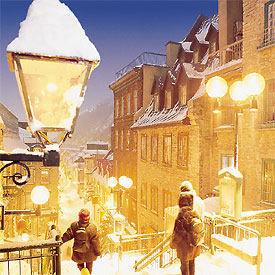 I'm standing on an ornate Victorian boardwalk built on cliffs above the mighty St. Lawrence River. Behind me towers Québec City's fairy-tale castle, the Fairmont Château Frontenac. Below is 17th-century Lower Town, an area of cobblestone streets and picturesque stone buildings that now house bistros, art galleries, museums, and shops in which I love to linger.
I'm standing on an ornate Victorian boardwalk built on cliffs above the mighty St. Lawrence River. Behind me towers Québec City's fairy-tale castle, the Fairmont Château Frontenac. Below is 17th-century Lower Town, an area of cobblestone streets and picturesque stone buildings that now house bistros, art galleries, museums, and shops in which I love to linger.
This is my favorite Canadian city, where romance lingers in the air. It is a feeling that is enhanced in wintertime, when fluffy drifts drape the steeply gabled roofs of the old port and transform already European-looking streetscapes to picture-postcard perfection.
Québec City embraces the season of snow annually during its internationally renowned "Carnaval de Québec," touted as the largest winter festival in the world. Everyone adopts a celebratory spirit, dons snowsuits of every color and description, and takes to the city's streets and parks which are transformed into dog-sled racetracks through to a splendid ice castle, complete with turrets. It is home to Carnival's rotund mascot, Bonhomme (French for "snowman"), a towering figure wearing a jaunty red French Canadian toque (wool hat) and multi-colored ceinture flechée (cummerbund belt). He strolls about, posing with passers-by and cajoling youngsters into matching his merriment.
Carnaval runs annually from late January through mid February (January 27-February 12, 2006). Many of its events represent highlights that truly should not be missed: from my favourite spectacle, the Mardi-Gras costume ball (costumes can be rented) through to concerts, a canoe race across the ice-covered St. Lawrence River, international snow- and ice-carving competitions, plus horse-drawn sleigh and dogsled rides. My tip: if you're not used to snow, the key to enjoying winter is to dress warmly, Once you are cosily clad (including toque, mittens and boots), the snow and plunging thermometer simply become natural backdrops to fun. 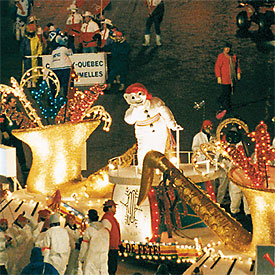 However, Québec City is not solely the spirit of Carnaval. Once upon a time, it was the capital of Nouvelle (New) France, a region extending from the Atlantic to the Mississippi. The city was founded in 1608 by French explorer Samuel de Champlain, who became the first Governor of the French territory. The strategic little village prospered. Then along came British General Wolfe, who defeated France's General Montcalm on the Plains of Abraham in 1759: their thirty-minute battle represented the Conquest of New France. At the Discovery Pavilion on the Plains — which are also called Battlefields Park — multimedia exhibits reveal Wolfe's strategy and Montcalm's false sense of security. Here also, the Citadelle Museum explains how the British shored up their defenses by transforming the walled fortifications built by the French into a star-shaped fortress. While being a culture vulture, take in Québec's Museum of Fine Art, which in autumn 2005 became home to a significant collection of Inuit art.
However, Québec City is not solely the spirit of Carnaval. Once upon a time, it was the capital of Nouvelle (New) France, a region extending from the Atlantic to the Mississippi. The city was founded in 1608 by French explorer Samuel de Champlain, who became the first Governor of the French territory. The strategic little village prospered. Then along came British General Wolfe, who defeated France's General Montcalm on the Plains of Abraham in 1759: their thirty-minute battle represented the Conquest of New France. At the Discovery Pavilion on the Plains — which are also called Battlefields Park — multimedia exhibits reveal Wolfe's strategy and Montcalm's false sense of security. Here also, the Citadelle Museum explains how the British shored up their defenses by transforming the walled fortifications built by the French into a star-shaped fortress. While being a culture vulture, take in Québec's Museum of Fine Art, which in autumn 2005 became home to a significant collection of Inuit art.
Today, Québec City is the capital of Canada's province of Québec. While exploring, it's easy to imagine you're in Paris, particularly come summertime when patios and cafés spill into the street. Nevertheless, during winter you can lazily watch the world go by from the interior warmth of a bistro, while sampling one of Québec's award-winning microbrewery beers (try Fin du Monde) or sipping a glass of wine.
Of course, eavesdropping is de rigueur: Wolfe might be aghast at how proudly French Québec City remains. Although that language predominates, most everyone speaks a bit of English, so come to practice your French or pick up some of the language. Everywhere you go, you will be greeted with a friendly "bonjour!" (good day), which all of us can manage after a time or two. (Pronounced "bon-joor," you'll find your attempts to speak French will be welcomed by all and sundry.)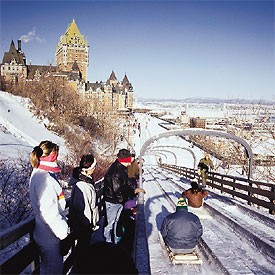 Québec City was designated a UNESCO World Heritage Site in 1985 because it is the only walled city in North America. These fortifications can be toured, and during snow season, the Plains of Abraham becomes transformed into a winter playground where you can join locals cross-country skiing in the heart of their city. Often as not, the spires of nearby cathedrals and peaked roofs pierce one of winter's unforgettable crystal-blue skies, providing a fantastical European-style architectural backdrop. Here upon the tops of the cliffs, you achieve an uninterrupted view of the St. Lawrence River below and gain an admiration for the climb General Wolfe and his army made in the shelter of night, before their defining victory occurred here upon the Plains.
Québec City was designated a UNESCO World Heritage Site in 1985 because it is the only walled city in North America. These fortifications can be toured, and during snow season, the Plains of Abraham becomes transformed into a winter playground where you can join locals cross-country skiing in the heart of their city. Often as not, the spires of nearby cathedrals and peaked roofs pierce one of winter's unforgettable crystal-blue skies, providing a fantastical European-style architectural backdrop. Here upon the tops of the cliffs, you achieve an uninterrupted view of the St. Lawrence River below and gain an admiration for the climb General Wolfe and his army made in the shelter of night, before their defining victory occurred here upon the Plains.
In fact, the fortifications still shelter Québec City's old town. Nowadays, instead of protecting residents from attack, they keep the march of modernity away from the cobblestone streets of Upper and Lower Town, where heritage structures await your discovery. Sure, there are the inevitable T-shirt and souvenir shops. . . but if you and your partner are dyed-in-the-wool romantics like my husband and me, these simply vanish. Let your imagination soar, and slip back in time. . .
Time travel is perhaps best started from the Dufferin Terrasse and Fairmont Château Frontenac, the former Canadian Pacific Railway Hotel, which forms the signature logo of Québec City. From here, find the funicular, a hybrid cable car that descends a steeply angled 45° slope down the cliff face, to deposit you in the Petit-Champlain quarter of Lower Town.
You'll step out into a restored 17th century landscape of charming stone buildings, where intimate bistros, cafés, and restaurants compete with shops and museums, enticing you to explore them all. Here, also, is Place Royale, the birthplace of Nouvelle (New) France. A façade of stone fronts this the former market square which, in summer, is full of people clad in 17th century costumes during August's Fêtes de la Nouvelle France (Festival of New France). Explore the Place Royale Interpretation Centre to learn the history of Champlain's first habitation, which was built here commencing on July 3, 1608. Across from it, don't miss stepping inside Notre Dame des Victoires Church, the oldest stone church in North America, built in 1688. Look up to spy the bronze replica of the Brezeau, a sailing ship that plied the Atlantic in the mid-1600s, which now floats in free space above the wooden pews, suspended from a vaulted ceiling. 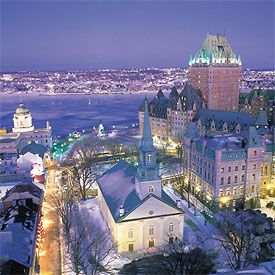 Exploring piques one's appetite and here your challenge will be selecting from the many restaurants whose menus — found outside the doorways, usually in protected box windows — tempt you. There's none finer in my opinion than Le Lapin Sauté, such a longstanding favourite among locals that it is prudent to reserve, even for lunch. For all the world, you'll feel just as if you stepped through a Narnia-like portal, into a French country inn. Everything rabbit is found here, from pâté to pie, but other excellent regional fare such as Charlevoix lamb can also be ordered.
Exploring piques one's appetite and here your challenge will be selecting from the many restaurants whose menus — found outside the doorways, usually in protected box windows — tempt you. There's none finer in my opinion than Le Lapin Sauté, such a longstanding favourite among locals that it is prudent to reserve, even for lunch. For all the world, you'll feel just as if you stepped through a Narnia-like portal, into a French country inn. Everything rabbit is found here, from pâté to pie, but other excellent regional fare such as Charlevoix lamb can also be ordered.
Returning to the castle atop the cliff (aka Fairmont Château Frontenac), clamber up "breakneck stairs," a steep staircase whose summit affords a true Kodak moment. The picturesque narrow streets you've just explored are best photographed from here — and of course rather nicely gives you a chance to catch your breath. Your next cardio workout is provided by a second staircase up the cliffs, which returns you to the Dufferin Terrace and Château Frontenac. More photographs of the roofs of the old port with the St. Lawrence River as a backdrop will give you great souvenirs of your tour of this Paris of the North.
No description of Québec City is thorough without a mention of the Château Frontenac where kings and queens, presidents and people like you and me love to stay. Why? Because it sets a mood of grand Victorian opulence, with its interiors of dark panelled wood, superb service, splendid rooms and restaurants. Yes, you will pay extra for a river view — but surely, it's worth it for an evening of romance in what is one of North America's most historic cities.
Regardless of whether or not you choose to stay at "the Castle," do make a reservation for a meal here. The hotel's Sunday buffet is renowned, so make a reservation so that you can sample what is an always beautifully designed smorgasbord of regional specialties, including Québec's famous maple syrup products.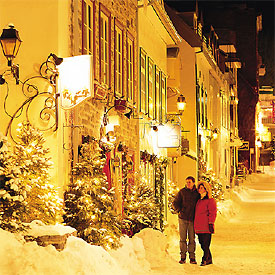 Although locals find it indescribably touristy, nonetheless I recommend first-timers to dine at Aux Anciens Canadiens, also in Upper Town across from the Château Frontenac. Here, wait staff in French Canadian peasant costumes serve traditional Québecoise fare. Look for salmon from the Gaspé region, lamb from Charlevoix region, or tourtire (meat pie) from the Lac St. Jean area.
Although locals find it indescribably touristy, nonetheless I recommend first-timers to dine at Aux Anciens Canadiens, also in Upper Town across from the Château Frontenac. Here, wait staff in French Canadian peasant costumes serve traditional Québecoise fare. Look for salmon from the Gaspé region, lamb from Charlevoix region, or tourtire (meat pie) from the Lac St. Jean area.
After your candlelit meal, stroll to Rue des Tresors, where local artists exhibit their works en plein air. Even in the depths of winter the artists are there, and it's fun to crunch through the snow, linked arm-in-arm with your partner, to visit the creators and admire their prints, serigraphs and other artworks.
History and romance are inescapable in Québec City. Moreover, when venturing through the gates of the old city perhaps you will feel just like me — startled because you can so readily believe you are slipping back in time, to a place of timeless enchantment.
Tourist Information:
Québec is very affordable. The current exchange rate gives you approximately $1.15 Canadian for every American dollar. Language tip: Note that websites for Québec usually have an "English" hot link.
Tourism Québec (418-641-6290; http://www.bonjourquebec.com/anglais/) Ask them to mail you the indispensable "Québec City and Area 2006 Official Tourist Guide."
Québec City Tourism (http://www.quebecregion.com/e/) for information on airports, car rentals, accommodations, events, and sights.
Where to Stay:
Fairmont Château Frontenac (http://www.fairmont.com/frontenac)
Hôtel du Capitole (http://www.lecapitole.com): luxury hotel with 40 rooms, restaurant, cabaret, and theatre.
Hôtel le Priori (http://www.epoquehotels.com): an inn located in a restored 1821 stone building.
Where to Eat:
Fairmont Château Frontenac (http://www.fairmont.com/frontenac) offers the sunny, moderately priced Café de la Terrasse (418-691-3763) — enjoy its opulent smorgasbord Sunday brunch; or the hotel's fine dining room, Le Champlain, where Chef Jean Soulard works wonders with fresh local products.
Le Lapin Sauté (418-692-5325; http://www.lapinsaute.com) is a local favorite in Lower Town. With its Parisian-style terrace, it resembles a country restaurant. Try rabbit pie followed by crème brûlé. Dinner for two with wine is about $85.
At Aux Anciens Canadiens (418-6921627; http://www.auxancienscanadiens.qc.ca), peasant-costumed staff serve traditional fare such as tourtière (meat pie) and tarte au sucre (sugar pie) at moderate prices.
Café Resto Le Hobbit (418-647-2677) serves Québec favorites such as crôque monsieur (melted cheese over an open-faced ham sandwich). Inexpensive to moderate.
Pub Thomas Dunn (418-692-4693) offers pub fare and an outstanding selection of single-malt scotch and beer. Sample a pint from Unibroue, a Québec microbrewery. Tip: Many Canadian beers have more alcohol than American brews — Québec's beer can be particularly potent.
Events:
Carnaval: http://www.carnaval.qc.ca/e; for information and lodging, contact, toll-free, 866-422-7628.
Summer Festival (Festival d'été): http://www.infofestival.com; for information and lodging, contact, toll-free, 888-992-5200.
New France Festival (Fêtes de la Nouvelle France): toll-free 866-391-3383
Things to Do:
Place Royale Centre of Interpretation http://www.mcq.org
Discovery Pavilion: http://www.museocapitale.qc.ca
The Citadelle: http://www.lacitadelle.qc.ca
Québec Museum of Fine Art: http://www.museeduquebec.org
Funicular from Dufferin Terrace in Upper Town to Lower Town: http://www.funiculaire-quebec.com
Excursions:
Ice Hotel (Hôtel de glace, http://www.hoteldeglace.qc.ca) is constructed every year beside Lac St. Joseph, a 30 minute drive west of Québec City. Literally constructed from ice and snow, it is only open from January to April (pending season) because it melts away come spring. Thirty or so rooms are all carved with different decorations, and you'll sleep on a bed built on a block of ice — where a foam mattress is covered with deer hides. You will be outfitted with cozy Arctic weight sleeping bags, but do take your own woollen or polar fleece hat. Attractions in the hotel include the Absolut Vodka Ice Bar through to ice sculptures — and even an ice chapel, where partners can exchange or renew their vows. Adjacent to the ice hotel is a boutique hotel, Station touristique Duchesnay, overlooking the lake. Packages allow you to stay one night at the ice hotel, the second at the boutique hotel. Also, there are picturesque cabins by the lake, complete with wood stoves and a full kitchen, where you can cook your own meals. On-site are miles of cross-country skiing and snowshoeing trails, which in summer are hiking trails taking you through the forested hills.
Chutes Montmorency, (http://www.sepaq.com/chutemontmorency) is 15 minutes north-east of Québec City. It is a natural wonder of the region where. during winter, mist from the towering falls (98 ft/30 m) creates an ice formation known as "the sugarloaf." During the era of horse and buggy, Québec City residents would ride in style in horse-drawn sleighs to the falls, where onlookers would watch horse races on the ice. Today, walk to the falls or, enquire about ice climbing the frozen face of the waterfall. Atop the falls is a restored inn, Manoir Montmorency, where you can visit a small museum and dine (reservations 418-663-3330).
Île d'Orléans (http://www.iledorleans.com) is a 20-minute drive east of Québec City, is a pastoral island perfect for cross-country skiing, or simply relaxing by a fireplace with a good book. In summertime, Quebeckers drive here to pick strawberries, visit a chocolate factory called La Chocolaterie de Île d'Orléans (418-828-2252), and dine on regional fare at Auberge Le Canard Huppé Inn (http://www.canard-huppe.com).
Charlevoix (http://www.bonjourquebec.com/anglais/regions/charlevoix.html) a visually stunning region 90 minutes north-east of the capital, offers breathtaking views of the Laurentian mountains, verdant farmland, and "la mer" (the sea), which is what the St. Lawrence River is called at this point. Drive La Route des Saveurs (the Flavor Trail) to taste Charlevoix's famous lamb and cheeses.
Alpine skiers, boarders, dog sledders, snowshoers will want to head 40 minutes east of Québec city to Monte Ste Anne's slopes (http://www.mont-sainte-anne.com, http://www.MontSteAnneSkiTrips.com). And if you're just wanting to see the views, don't let the ski crowd intimidate you: the gondola ride to the summit of Mont Ste. Anne rewards you with a stunning view of the St. Lawrence River, Île d'Orléans, the increasingly mountainous topography of the Charlevoix region, and, immediately below you to the west, Québec City. Bring your binoculars and spy the Fairmont Château Frontenac and appreciate why it's the capital's landmark.

